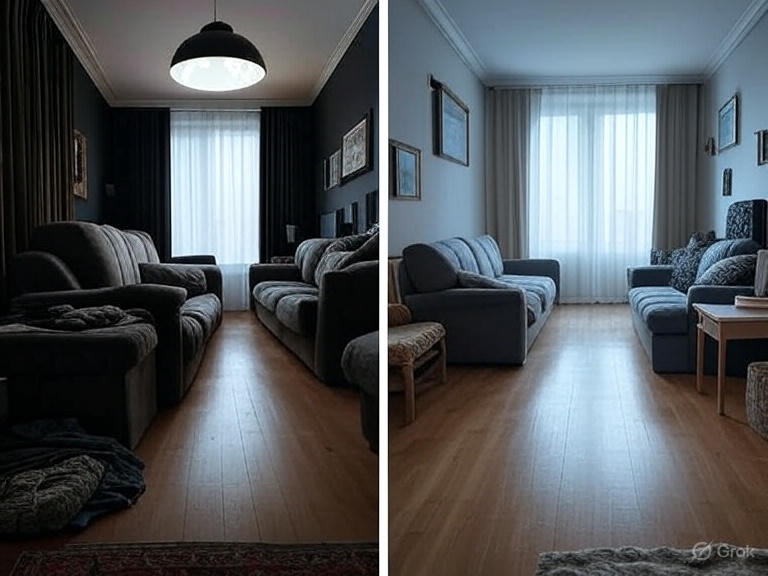
Interior Designing Mistakes That Make Small Spaces Appear Even Smaller
Working with small spaces can be a challenge but at the same time brings immense benefits. With limited space, each and every decision matters, from positioning furniture to colors. If done appropriately, a small space can be cozy, functional, and even spacious. But some simple interior design errors have the reverse effect, and the room appears even smaller and more cramped than its actual size. Such errors tend to occur due to ignorance of simple principles like scale, light, and organization. In this blog, we are going to examine five simple errors that make small rooms appear smaller and more cramped both in appearance and functionality. For each, we will discuss the problem, how it impacts us, and simple solutions to repair it. Having these traps in mind, anyone can make their space feel more open and inviting in small living areas.
1. Choosing Oversized or Too Much Furniture
One of the main mistakes in small rooms is selecting furniture that is too large or loading the room with too much. An example would be a huge couch consuming too much space in the living area, or an enormous bed having little room to get around in a bedroom. Loading in more chairs, tables, or cabinets without considering the measurement of the room just makes the problem worse.
This technique is blocking natural movement and limiting how the person may move about, creating the illusion of a crowded atmosphere. The room appears cluttered and closed off, which emphasizes the small nature of the space rather than hiding it.
To fix this, take notice of proportionally decreasing furniture size:
- Measure the room initially and choose furniture items that are in proportion without overpowering the area.
- Select multifunctional items, such as nesting tables or sofa beds, that serve a double purpose without taking up more space.
- Restrict open floor areas by reducing the quantity and grouping them against walls to leave central spaces free.
These adjustments add up to balance and provide a light and airy feel in the room.
2. Overlooking Light and Color
Another common error is not taking natural light and color choice into consideration. This can include overwhelming windows with dense curtains or blinds, or keeping wall paint at dark shades like deep browns or blacks. These will cause the space to feel stuffy and gloomy.
The impact is a box-shaped and dull-looking room, as light gives the impression of a greater space. Black paint will absorb light as well, reducing the space perceived and making the room less inviting.
To correct this is to maximize light and color use:
- Use sheer curtains or sun-screening blinds in order to allow sunlight in without sacrificing privacy.
- Add mirrors and glass furniture pieces to reflect light and give an illusion of depth.
- Paint walls a light, neutral shade like soft white or pastel, and add small amounts of color in the way of pillows or artwork.
These makeovers brighten the space and open up the room’s visual space.
3. Poor Space Planning and Layout
Poor planning of the room layout is a typical issue, where furniture is simply pushed in without regard to flow and balance. Items can get pushed into corners with little care or placed in arrangements that result in uncoordinated geometries.
This leads to inefficient use of space, with cramped and difficult-to-navigate zones. Impeded doorways or wasted corners contribute to a sense of untidiness, making the room look even more compact.
To get the most out of this, thoughtfully plan the layout:
- Set up specific areas to use, such as a work corner or seating area, to methodically subdivide the room.
- Leave space, open areas where the eye can relax and define space.
- Place furniture to direct movement naturally, such as placing a coffee table in the center only if it doesn’t cut off paths.
Thoughtful planning turns chaotic rooms into efficient, spacious ones.
4. Décor, Pattern, and Texture Overdoing
Excessive use of décor items, heavy patterns, or mixture textures is another danger. Crowding shelves with numerous small items, wallpapering with busy papers, or stacking opposite fabrics on top of each other can overwhelm the eye.
This results in visual clutter, whereby space becomes congested and tight. Excessive detail directs attention to the clutter rather than the space itself, whereby everything seems smaller.
The solution is to simplify and select well:
- Pick a few statement pieces, like a large vase or art, instead of a excess of small trinkets.
- Employ subtle patterned prints or avoid patterns altogether, with the exception of coordinating stripes on pillows and rugs.
- Employ textures sparingly, mixing smooth and texture-obtrusive ones for added interest without going too far.
This thoughtful balance maintains the room serene and spacious.
5. Omitting Smart Storage and Lighting Layers
Omission of smart storage and keeping just one light source is a serious oversight. Keeping things on open surfaces or relying solely on overhead ceiling lighting gives the room clutter and flatness.
Clutter builds up, shadows settle in corners, and the space lacks depth, all highlighting its compact nature.
One has to ensure there are integrated solutions to get out of this problem:
- Use out-of-sight storage such as under-bed drawers, storage ottomans, or wall shelves to declutter surfaces.
- Overlayer lighting with ambient sources like floor lamps, reading task lights, and accent lights to light features.
- Combine these to establish warmth and depth, drawing the eye up or across the room.
Proper storage and lighting make cramped rooms appear neat and larger.
Conclusion
Avoiding these five mistakes, furniture that is too large, ignoring light and colour, ugly configuration, excessive décor, and not giving enough importance to storage and lighting, can do miracles for small rooms. With every tweak, the space begins to feel spacious, making it more inviting and fashionable. Through thoughtful choices, even the tiniest spaces can be turned into bright and cozy sanctuaries. Readers can try experimenting by altering one or two elements to see the difference, or hire a design professional to totally optimize their house.


0 comments